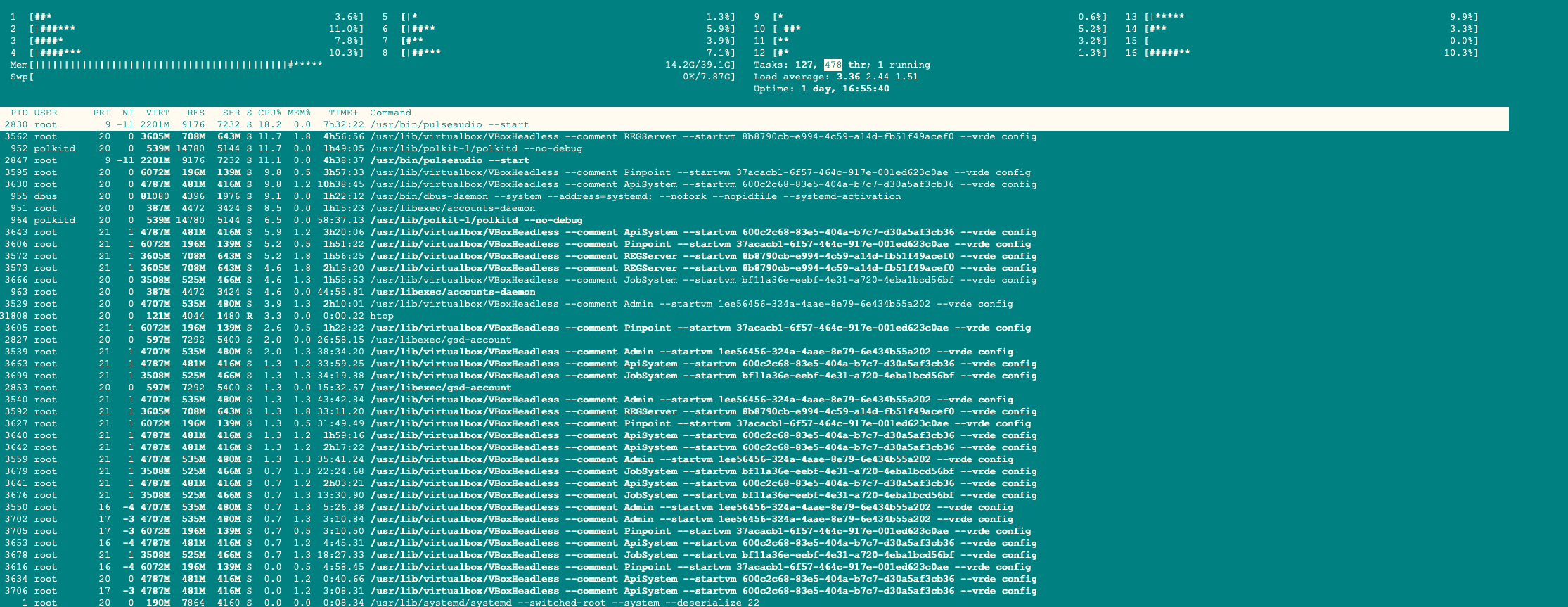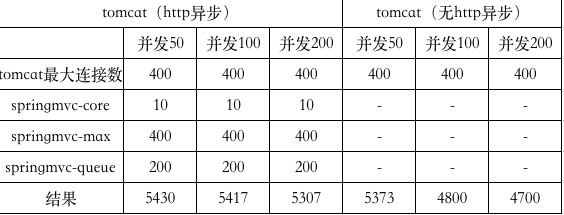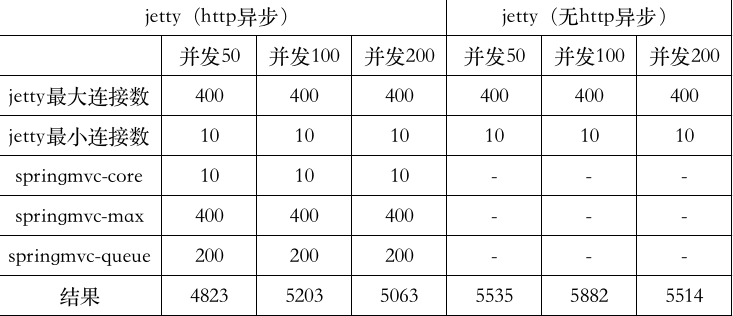一、前言
昨天发了一个《SpringBoot服务器压测对比(jetty、tomcat、undertow)》,本是工作的一个笔记,没想到被红薯翻牌了(荣幸之至)。看了OSCer的回复,感觉需要重新梳理下,因为确实存在描述不清和不合理的配置。
这篇博客的目的,不是复述上一篇博客,而是尽量规范的去做一次压测对比,并且能够清晰的描述出过程和结果。
二、准备
1、服务器
为了保证尽量少的干扰,这里不再在虚拟机上运行服务,而是直接在物理机上运行服务,并且在这台物理机上安装ab工具。
服务器配置是2个CPU,单个CPU8核,总共内存40G,1T的RAID5机械硬盘。服务器安装的系统是Centos7.5,系统优化同《Centos7高并发优化》所述。但额外的,因工作需要,这台物理机上有6个虚机,是不能关闭的。以下是简单的top展示:

2、测试项目
感谢@TGVvbmFyZA 的建议,测试项目不再使用生产项目,而是从Springboot官网打包2.x版本的项目,这样的目的是减少生产项目中不必要的依赖,从而避免不必要的开销。以下是简单的项目介绍:
| 序号 | 名称 | 版本 |
| 1 | springboot | 2.1.1 |
| 2 | java | 1.8 |
我已将项目放到Gitee,地址:https://gitee.com/loveliyiyi/test4server
以下贴出关键代码,以便更好理解。
package com.shy.test4server;
import org.springframework.stereotype.Controller;
import org.springframework.web.bind.annotation.GetMapping;
import org.springframework.web.bind.annotation.RequestMapping;
import org.springframework.web.context.request.async.WebAsyncTask;
/**
* @ClassName: TestController
* @Description: TODO(这里用一句话描述这个类的作用)
* @author chengcai.shang@cmgplex.com
* @date 2018年12月7日 上午9:36:25
*
*/
@Controller
@RequestMapping("/test")
public class TestController {
/**
* 未使用HTTP异步的接口
*
* @Title: testCeilingNoAsync
* @Description: TODO(这里用一句话描述这个方法的作用)
* @date 2018年12月7日 上午9:40:57
*/
@GetMapping("/testCeilingNoAsync")
public String testCeilingNoAsync() {
return "";
}
/**
* 使用HTTP异步的接口
*
* @Title: testCeilingNoAsync
* @Description: TODO(这里用一句话描述这个方法的作用)
* @date 2018年12月7日 上午9:40:57
*/
@GetMapping("/testCeilingWithAsync")
public WebAsyncTask<String> testCeilingWithAsync() {
return new WebAsyncTask(() -> {
return "";
});
}
}
3、项目优化
不同的服务器容器优化参数均不一致,以下是本次测试主要优化的地方:
| 序号 | 服务容器 | 优化参数 |
| 1 | tomcat | 最大连接数server.tomcat.max-threads=400 |
| 2 | jetty | 最大连接数(400)和最小连接数(10) |
| 3 | undertow | cpu核数(16)和工作线程数(400) |
| 4 | http异步 | 线程池core=10,max=400,queue=200 |
以下优化步骤:
针对tomcat,在application.properties中加入server.tomcat.max-threads=400即可。
针对jetty,在config目录加入JettyConfig类
package com.shy.test4server.config;
import org.apache.catalina.Server;
import org.springframework.boot.web.embedded.jetty.JettyServerCustomizer;
import org.springframework.context.annotation.Bean;
import org.springframework.context.annotation.Configuration;
/**
* @ClassName: JettyConfig
* @Description: TODO(这里用一句话描述这个类的作用)
* @date 2018年12月7日 上午9:53:46
*
*/
@Configuration
public class JettyConfig {
@Bean
public JettyEmbeddedServletContainerFactory jettyEmbeddedServletContainerFactory(
JettyServerCustomizer jettyServerCustomizer) {
JettyEmbeddedServletContainerFactory factory = new JettyEmbeddedServletContainerFactory();
factory.addServerCustomizers(jettyServerCustomizer);
return factory;
}
@Bean
public JettyServerCustomizer jettyServerCustomizer() {
return server -> {
threadPool(server);
};
}
private void threadPool(Server server) {
// Tweak the connection config used by Jetty to handle incoming HTTP
// connections
final QueuedThreadPool threadPool = server.getBean(QueuedThreadPool.class);
// 默认最大线程连接数200
threadPool.setMaxThreads(100);
// 默认最小线程连接数8
threadPool.setMinThreads(20);
// 默认线程最大空闲时间60000ms
threadPool.setIdleTimeout(60000);
}
}
针对undertow,在application.properties中加入server.undertow.io-threads=16和server.undertow.worker-threads=400即可
针对http异步,优化代码如下:
package com.shy.test4server.config;
import org.springframework.context.annotation.Bean;
import org.springframework.context.annotation.Configuration;
import org.springframework.scheduling.concurrent.ThreadPoolTaskExecutor;
import org.springframework.web.servlet.config.annotation.AsyncSupportConfigurer;
/**
* @ClassName: SpringmvcConfig
* @Description: TODO(这里用一句话描述这个类的作用)
* @date 2018年12月7日 上午9:59:06
*
*/
@Configuration
public class SpringmvcConfig {
@Bean
public void configThreadPoll(AsyncSupportConfigurer asyncSupportConfigurer) {
ThreadPoolTaskExecutor threadPool = new ThreadPoolTaskExecutor();
threadPool.setCorePoolSize(10);
threadPool.setMaxPoolSize(400);
threadPool.setQueueCapacity(200);
threadPool.initialize();
asyncSupportConfigurer.setTaskExecutor(threadPool);
}
}
另,所有测试中,日志均关闭。
三、压测方案
由于三个服务器的优化参数不一致,没法做统一配置,然后观察结果。故只能不断调整参数获取最大的结果,然后比对最终结果,虽然这样得出结果有点片面,但目前也只能这么干。另外,不再辅以Jprofiler监控,因为Jprofiler会影响一定得性能。以下是压测步骤:
1、使用tomcat,压测两个接口,按不同并发访问10000次,然后不断调整参数,获取最大结果。由此可得出纯tomcat和tomcat+http异步的结果。
2、使用jetty,压测两个接口,按不同并发访问10000次,然后不断调整参数,获取最大结果。由此可得出纯jetty和jetty+http异步的结果。
3、使用udertow,压测两个接口,按不同并发访问10000次,然后不断调整参数,获取最大结果。由此可得出纯udertow和udertow+http异步的结果。
四、压测过程
1、tomcat
启动命令
java -server -Dserver.tomcat.max-threads=400 -Dspringmvc.thread.core=10 -Dspringmvc.thread.max=400 -Dspringmvc.thread.queue=200 -Xms512m -Xmx512m -jar test4server.jar压测命令
ab -n 10000 -c 50 http://localhost:8080/test/testCeilingNoAsync
ab -n 10000 -c 100 http://localhost:8080/test/testCeilingNoAsync
ab -n 10000 -c 200 http://localhost:8080/test/testCeilingNoAsync
ab -n 10000 -c 50 http://localhost:8080/test/testCeilingWithAsync
ab -n 10000 -c 100 http://localhost:8080/test/testCeilingWithAsync
ab -n 10000 -c 200 http://localhost:8080/test/testCeilingWithAsync压测结果:

2、jetty
启动命令
java -server -Djetty.thread.max=400 -Djetty.thread.min=10 -Dspringmvc.thread.core=10 -Dspringmvc.thread.max=400 -Dspringmvc.thread.queue=200 -Xms512m -Xmx512m -jar test4server.jar压测命令
ab -n 10000 -c 50 http://localhost:8080/test/testCeilingNoAsync
ab -n 10000 -c 100 http://localhost:8080/test/testCeilingNoAsync
ab -n 10000 -c 200 http://localhost:8080/test/testCeilingNoAsync
ab -n 10000 -c 50 http://localhost:8080/test/testCeilingWithAsync
ab -n 10000 -c 100 http://localhost:8080/test/testCeilingWithAsync
ab -n 10000 -c 200 http://localhost:8080/test/testCeilingWithAsync压测结果:

3、undertow
启动命令
java -server -Dserver.undertow.io-threads=16 -Dserver.undertow.worker-threads=400 -Dspringmvc.thread.core=10 -Dspringmvc.thread.max=400 -Dspringmvc.thread.queue=200 -Xms512m -Xmx512m -jar test4server.jar压测命令
ab -n 10000 -c 50 http://localhost:8080/test/testCeilingNoAsync
ab -n 10000 -c 100 http://localhost:8080/test/testCeilingNoAsync
ab -n 10000 -c 200 http://localhost:8080/test/testCeilingNoAsync
ab -n 10000 -c 50 http://localhost:8080/test/testCeilingWithAsync
ab -n 10000 -c 100 http://localhost:8080/test/testCeilingWithAsync
ab -n 10000 -c 200 http://localhost:8080/test/testCeilingWithAsync压测结果:

五、压测结果
1、关于HTTP异步
HTTP异步的目的在帮助dispatcherservlet分担压力,提升吞吐量。但如果运行在NIO模式的服务容器上,就会产生负面影响,因为NIO本身就做了类似的事情,此时再加HTTP异步,则相当于又加了N多不必要的线程,导致性能主要消耗在线程的开销上,所以建议使用tomcat作为内嵌容器并且没有开启tomcat的NIO模式时,可以配合HTTP异步来提升程序性能。尤其是当业务繁重时,提升效果尤其明显。
2、关于服务容器
在基于天花板接口的测试中,综合对比tomcat、jetty、undertow,可以发现undertow相对性能更高点。但此结果并不一定准确,因为测试方案里只进行了很简单的参数调整,以及并没有针对实际业务代码进行测试。不过源码我已提供,有兴趣的可以实际测试下。
来源:oschina
链接:https://my.oschina.net/u/2358114/blog/2980868